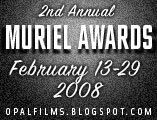Fata Morgana (1971)
The more Werner Herzog I see, the more I like. This strange, surreal and gorgeous rumination on creation and creation myths opens with a fantastic series of shots -- a series of planes descend from the sky and land on a airstrip in foggy long shots, so that they appear almost as mirages. It's like seeing a literal deus ex machina, except that when the machine comes down, it delivers the beginning of the story instead of the end. The film that follows is divided into three parts ("Creation," "Paradise," and "The Golden Age"), and one can chart the progress of humanity as it slowly intrudes into the desolate landscapes that comprise much of the film's first two-thirds. There are almost no people to be seen in "Creation" (when they are seen, it's usually from a distance, like the people walking on the horizon), while little alcoves of humanity start to appear in "Paradise." (One of the most stunning shots in the whole film is in this second part, where we first get a glimpse of green after a mass of cracked and barren desert photography.) The encroaching irony, present in the segment title and self-conscious narration, that crops up in "Paradise" reaches full flower in "The Golden Age," where we go from the mystical and alien world of the uninhabited desert to the banal existence of those who've made it their home. Case in point: The man and woman (apparently a pimp and a brothel madam) who play bad keyboard music and sing tunelessly and tirelessly. The contrast is clear -- as odd as the world is, we as a species are even odder. Maybe those planes were bringing the end of the story after all.
Grade: B
The more Werner Herzog I see, the more I like. This strange, surreal and gorgeous rumination on creation and creation myths opens with a fantastic series of shots -- a series of planes descend from the sky and land on a airstrip in foggy long shots, so that they appear almost as mirages. It's like seeing a literal deus ex machina, except that when the machine comes down, it delivers the beginning of the story instead of the end. The film that follows is divided into three parts ("Creation," "Paradise," and "The Golden Age"), and one can chart the progress of humanity as it slowly intrudes into the desolate landscapes that comprise much of the film's first two-thirds. There are almost no people to be seen in "Creation" (when they are seen, it's usually from a distance, like the people walking on the horizon), while little alcoves of humanity start to appear in "Paradise." (One of the most stunning shots in the whole film is in this second part, where we first get a glimpse of green after a mass of cracked and barren desert photography.) The encroaching irony, present in the segment title and self-conscious narration, that crops up in "Paradise" reaches full flower in "The Golden Age," where we go from the mystical and alien world of the uninhabited desert to the banal existence of those who've made it their home. Case in point: The man and woman (apparently a pimp and a brothel madam) who play bad keyboard music and sing tunelessly and tirelessly. The contrast is clear -- as odd as the world is, we as a species are even odder. Maybe those planes were bringing the end of the story after all.
Grade: B


0 Comments:
Post a Comment
Subscribe to Post Comments [Atom]
<< Home